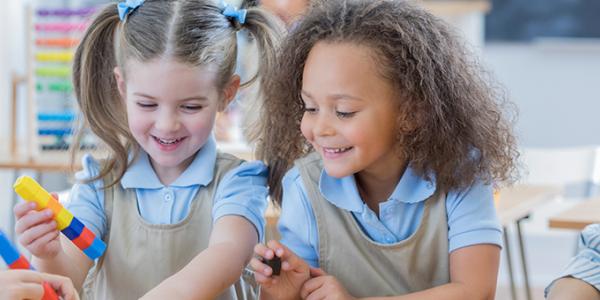What Does a High-Quality Primary Classroom Look Like?

You are here
In a high-quality classroom, teachers follow five guidelines to promote children's learning.
Creating a Caring Community of Learners
To help all children feel accepted and to encourage a positive atmosphere, teachers create a sense of classroom community. Teachers:
- Are warm and caring, get to know each child in the class, and encourage children's friendships
- Create opportunities for students to share their interests and parts of their culture
- Make sure all children, including dual language learners and those with delays or disabilities can participate and feel successful in all classroom activities
Teaching to Support Children's Learning
Teachers create environments and schedules that allow children to actively participate with learning materials and with each other, which is how they learn best. They encourage children's efforts and give personal feedback to support their continued learning and self-confidence. They also:
- Design organized spaces that invite children to explore, choose activities, and interact with others.
- Choose materials and activities that inspire children's curiosity for learning and help make a subject more real to them.
- Use strategies that support deeper levels of understanding, like asking children questions to help them dig into what they're studying and encouraging them to come up with different solutions.
- Offer children many opportunities to practice social skills during group work and whole class discussions.
Planning and Adapting Curriculum
A curriculum is based on what students should know and be able to do in all areas of learning. It includes the materials, strategies, and approaches teachers use to help children learn. (For more on specific curriculum areas in the primary grades, see pages 6–11.) To help all students achieve, teachers:
- Create learning activities that respect children's experiences. Books and other resources in the room include characters of different races, ages, abilities, genders, and cultures.
- Develop lessons that connect subjects, like social studies and language arts. They also introduce long-terms projects that require students to use skills from different subject areas.
Assessing Children's Knowledge and Skills
Teachers use different assessment methods to evaluate students throughout the learning process and school year. Teachers assess children to:
- Plan and adapt the curriculum to meet each child's needs
- Monitor children's progress
- Evaluate and improve their teaching
- Measure the children's and school's progress toward state learning standards
- Screen students for possible delays, disabilities, or special learning needs
To assess children's learning, teachers:
- Record children's learning as it happens, when possible. They use this information to shape their teaching.
- Regularly check each child's progress toward goals. They use the results to make decisions about instruction and resources.
- Make decisions about individual goals and how to group children for learning. These decisions are based on observations, in-class assessments, and discussions with families and specialists.
Developing Relationships With Families
In high-quality classrooms, teachers see families as partners. They rely on families to help them learn more about the children. Families are given regular updates about what's going on in school. Teachers:
- Welcome families in the classroom throughout the year. They invite families to support children's learning and celebrate their work.
- Use families' knowledge to help them better understand the students. Teachers listen to families' concerns and goals. Together, they work to address any issues that come up.
- Value families as a resource that supports the curriculum. For example, if your child's class is learning about plants, the teacher might ask family members who garden to share what they know with the students.
- Give families regular reports about children's progress and what they're studying. Teachers work to communicate effectively with everyone in the community.
Warning Signs
Learning standards are usually set by your state, and the curriculum is often decided by the school district. But each teacher chooses how to create a supportive environment, implement lessons, and interact with students and families. You could see some practices in your child's class that aren't supporting his learning. Some examples are listed here. If you're concerned about something you see or hear about, talk to the teacher or a school administrator.
- Most of the time, the teacher instructs the whole class. Children sit for long periods.
- Students don't have a lot of hands-on materials to help them with complex concepts, like a chart and counters for understanding place value. Children have to complete many worksheets.
- The curriculum, environment, and teaching strategies are the same for all children. Teachers don't connect learning to what a child knows or adapt to each student's needs. Because of this, some students are uninterested, struggle with learning the material, or may have behavior issues.
- Children's social and emotional needs aren't given much attention. They don't have chances to learn skills like problem solving or self-control. Teachers don't give genuine encouragement, relying instead on rewards or punishments to get children to participate, finish assignments, or behave.
- Teachers hardly ever use assessments to better understand each child's needs or evaluate their own teaching. Assessments might focus only on right and wrong answers, which doesn't help the teacher understand a child's thinking.
- Teachers don't keep families updated on their children's progress or involve them in decisions that affect children's learning.
Effective teachers know a lot about children and learning, and you know so much about your child—her interests, experiences, strengths, and needs. In high-quality schools, you'll partner with your child's teacher to make sure your child is learning and growing in all areas, enthusiastically and confidently. Here's to a bright future!